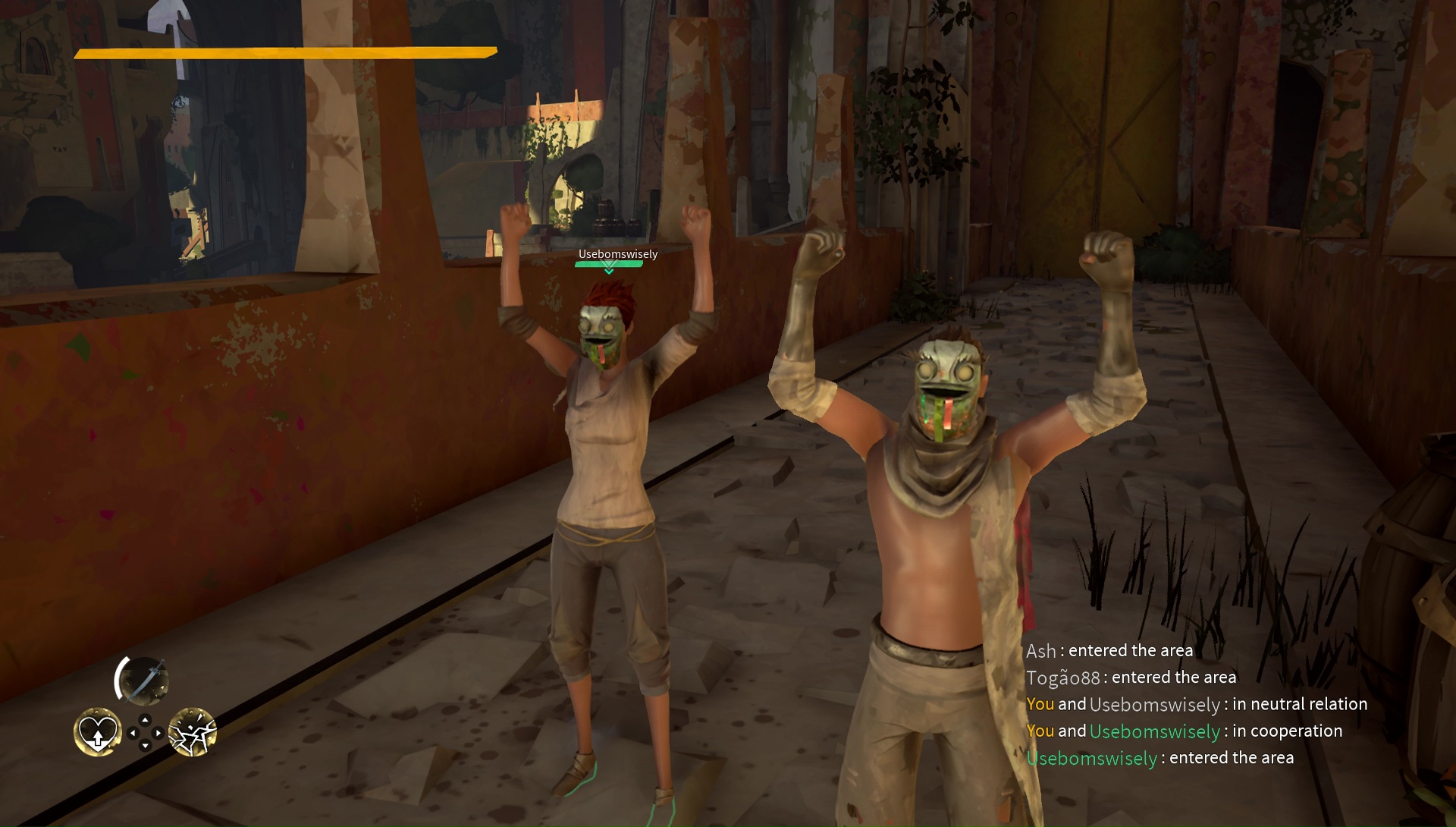8 things I wish I knew before playing Absolver
How to get started in the confusing world of masked martial arts.

When I first started playing Absolver, I didn't like it. The world is maze-like, fighting multiple enemies alone is frustrating, and the only guidance is to find 'Marked Ones' which are placed on a fairly unhelpful map. (And if you're using an ultrawide monitor, the map that appears at Altars is obscured by the black bars, something I only discovered recently.) Absolver makes a bad first impression.
I'm far from the best at PvP (or even good), but I've had a lot of hours in the game to develop a sense of what works and what doesn't. To help you get through the first few hours and out the other side with a character you want to keep building, I've compiled a few tips for the early game—because once you get it, it's great.
1. Find a friend
It doesn't actually take long to complete the open world stuff and become an Absolver—that is, get to the point where you can focus on learning new abilities, customizing your fight deck, and fighting other players. You just need a friend. If someone you know is already playing, join up with them and they can guide you through the boss fights. Otherwise, look for other players in the world and use the radial menu to cooperate with them. Many people I've found are happy to cooperate.
2. But go offline if you want to farm moves
Once you've got the hang of everything, you might get to a place where you just want to power level, or learn an NPC's moves by repeatedly fighting them. If you're going to be ignoring other players anyway, it's both polite and beneficial to just go offline. No one will get in the way, or fight the NPCs you're after, and you aren't taking up space in someone else's game if they're looking for someone to cooperate with.
3. Understand your healing power
You have two special abilities that are activated by using Shards collected through countering enemies. By default, the first is a healing ability, and the second is a knockback ability. You can swap these for other powers as you level up, but for starters you'll want to get real used to that healing ability—on controllers, it's the left d-pad, and on the keyboard, it's the number 1.
You'll notice it barely gives you any health. The way it works is this: score hits, and you'll gain health for each one. Take a hit, and you'll stop healing. In 1v1 matches, this creates an interesting dynamic because if one player heals, the other knows they have to score a hit as soon as possible, and take as few as they can beforehand.
You also get a big chunk of health when you defeat someone, so if you're fighting multiple NPCs, try to knock down weak ones to keep your health topped off.
The biggest gaming news, reviews and hardware deals
Keep up to date with the most important stories and the best deals, as picked by the PC Gamer team.
4. Fast attacks come first
If the first move for each of your stances is too slow, you're going to get socked in the face while you're winding up. In general, start with fast attacks to surprise your enemy and get a combo going, and save the heavy stuff for the ends of sequences.
There are exceptions where you might, for instance, want to start off a stance with a heavier counter to charge attacks so you can use it immediately when you need it.
5. Hit the timing on your combos
When you perform a move, your character will briefly flash gold—hit the attack button at that moment (you can also see this on your stamina gauge) and your next attack will happen much faster. I find that this moment is often (but not always) when I hear the hit sound effect, which helps me get into a rhythm. For bigger attacks, however, it usually comes near the end of the animation.
You can practice this in Meditation until it's second nature.
6. Keep it simple, but not too simple
Building too complex a deck early on was my initial failing—I wanted to use all my flashy new moves, meaning I didn't include enough basic punches, and I hadn't memorized the moveset I put into each stance. Keep it simple at first.
That said, you do want to vary high, low, sweeping, and charge attacks. Windfall opponents will mostly try to dodge left and right—it's tougher to land a duck or hop—and they'll probably try to throw out a jab immediately after dodging. So if you include a few low, sweeping attacks, you can catch them after a dodge and start to frustrate. If you use the same kind of attack too many times, however, your opponents will catch on and start succeeding with their defensive ability more often. Think about how you use yours, whether it's dodge, parry, or absorb, and which moves catch you off guard the most.
7. Build mini-combos
You can make a good deck that auto-cycles through every stance, but at first consider looping your most irritating combos and only breaking out of them once your opponent has caught on. One of my most successful combos early on was just two kicks that repeat: a standing low kick and a sweep that dodges high attacks. If I hit with the first kick, it appears that I'm vulnerable as it finishes, and my opponent often initiates their own attack. If they attack high—which a lot of them do—I get them again with the sweep. In general, when putting combos together, think about how you would react to each move, and then plan the next move to counter that reaction.
Clever opponents will see through you and adapt to repeat combos, so you may only get away with this in the lower ranks, later preferring variety as you unlock more attack slots and fight more experienced players.
8. Focus your stat allocation
There's currently no way to respec in Absolver, but there really should be. For now, you'll have to experiment with fighting styles early on to decide where you want to put points. Based on my formerly Windfall, now Stagger style character, and from talking to other players, these are my observations.
Strength or Dexterity: Once you have a moveset you like, pay close attention to which stats your attacks benefit most from (there's a letter grade for Strength, Dexterity, and Mobility, the latter of which is based on how cumbersome your armor is).
If it's primarily strength or dexterity, consider building a heavy hitter. You won't need as much health on account of wearing heavy armor, though you'll dash more slowly. Do note, however, that the damage increase you get with these stats decreases significantly above 12 or so points.
Vitality: If you're using Stagger style attacks (these must be unlocked in the game, especially by fighting Jinn Mesca and joining the Stagger School) then a lot of your power comes from mobility. This means you don't want to wear heavy armor, so you should beef up your health a bit. This goes for any style, though, if you plan to be light on armor and like to dodge.
Endurance: Ideally we'd all be so skilled with our special countering moves that we don't have to block much, but if you're struggling, more stamina can help you hold off combos. At the same time, it will let you chain heavier attacks to break the blocks of your opponents. A high Endurance, low damage build is possibly workable, though I haven't tried it. If you're going for a high strength build with heavy attacks, you definitely want lots of stamina to work with. If you don't know where to put a point, Endurance will always help.
Will: This helps you collect shards more quickly so that you can use your healing and other special abilities, and later on materialize a sword or war gloves. At the lowest level, I still find that I have enough heals per fight to get by, so I haven't given it any points. That's not necessarily the best strategy, as using weapons or punishing your opponent with special abilities is a pretty good way to turn a 1v1 fight in your favor—still, I'd say beef up your primary stats first, then give a nod to Will.
If you've been playing for awhile and don't like where your character has ended up, there is some good news. I made a new character today (the one you see in these gifs) and discovered that if you're in a school, new characters you create are too. So that will give you a fight deck to start with. With my experience from my first character, it's hardly taken any time to get to level 10. It's not the ideal way to respec, but not quite as onerous as I originally thought it would be.

Tyler grew up in Silicon Valley during the '80s and '90s, playing games like Zork and Arkanoid on early PCs. He was later captivated by Myst, SimCity, Civilization, Command & Conquer, all the shooters they call "boomer shooters" now, and PS1 classic Bushido Blade (that's right: he had Bleem!). Tyler joined PC Gamer in 2011, and today he's focused on the site's news coverage. His hobbies include amateur boxing and adding to his 1,200-plus hours in Rocket League.

